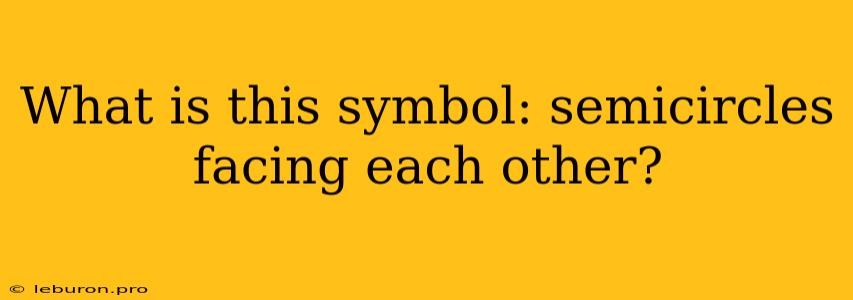The symbol formed by two semicircles facing each other is a common and widely recognized symbol that carries various meanings depending on the context. It can represent a variety of concepts, from mathematical operations to cultural symbols. This article will delve into the different interpretations and uses of this symbol, exploring its history, significance, and applications across various fields.
The Symbol of Unity and Harmony: Semicircles Facing Each Other
This symbol, often referred to as the "yin-yang" symbol, holds a profound significance in various cultures and belief systems. Its two semicircles, one black and one white, represent the interconnectedness and balance of opposing forces in the universe. The yin-yang symbol embodies the principle of duality, where opposing forces complement and interact with each other.
Origins in Chinese Philosophy
The yin-yang symbol originated in ancient Chinese philosophy and represents the two fundamental forces that govern the universe: yin and yang. Yin is associated with darkness, femininity, passivity, and the moon, while yang is associated with light, masculinity, activity, and the sun. These forces are not viewed as separate entities but rather as two sides of the same coin, constantly interacting and transforming into each other. The yin-yang symbol illustrates this dynamic relationship, where the black and white semicircles intertwine and contain a small dot of the opposite color within each other.
Interpretations and Applications
The yin-yang symbol has been interpreted and applied in various ways across different disciplines:
- Philosophy and Religion: In Taoism, the yin-yang symbol represents the fundamental principle of the Tao, the ultimate reality. It emphasizes the interconnectedness of all things and the importance of finding balance and harmony between opposing forces.
- Art and Design: The yin-yang symbol has been widely used in art and design as a powerful visual representation of duality, balance, and harmony. It appears in various forms of art, from traditional Chinese painting to modern graphic design.
- Medicine and Health: In traditional Chinese medicine, the yin-yang symbol represents the balance of energy in the body. It is believed that imbalances between yin and yang can lead to illness, while restoring balance can promote health and well-being.
- Psychology: The yin-yang symbol has also been explored in psychology, where it represents the integration of conscious and unconscious aspects of the self.
Variations and Symbolism
While the traditional yin-yang symbol is a black and white representation, variations exist in different cultures and contexts. For example, the yin-yang symbol can be depicted in different colors, such as red and blue, or with additional elements, such as a dragon and a tiger, to represent specific concepts or beliefs.
Modern Relevance
The yin-yang symbol remains a relevant and powerful symbol in the modern world. Its message of balance, harmony, and interconnectedness resonates across cultures and beliefs. The symbol continues to be used in various contexts, from business and branding to personal growth and self-discovery.
Beyond the Yin-Yang: Other Interpretations of Semicircles Facing Each other
While the yin-yang symbol is the most common interpretation of semicircles facing each other, other interpretations exist depending on the context. For example, in mathematics, two semicircles facing each other can represent the concept of a concave lens. A concave lens is a type of lens that is thinner at its center than at its edges and converges light rays that pass through it.
Conclusion
The symbol formed by two semicircles facing each other is a powerful and multifaceted symbol. It can represent the balance of opposing forces, as in the yin-yang symbol, or other concepts depending on the context. The symbol's significance lies in its ability to capture the essence of duality, interconnectedness, and harmony, making it a relevant symbol across cultures and disciplines.
